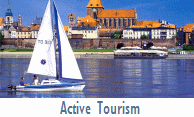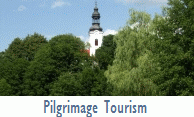........................................................................................................................................................................... Kuiavia-Pomerania is a region attractive for tourist craving peace and quiet in the open, historic monuments enthusiasts and history researches, globtrotters, aquatic sports aficionados and hunters, mushroom lovers, anglers and cyclist. The Kuiavia-Pomerania administrative region is located in the centre and north of Poland and is intersected by the River Vistula and its tributaries, including the Drwęca, Brda, Wda and Osa rivers. The Vistula divides the area into several historical and geographical regions. Its central part is occupied by the Valley of Toruń, located along the river, with the self-government capital of the region – Toruń.
The region encompasses a number of ethnographically, culturally, historically and geographically diverse lands. From the historical and cultural perspective, it is made up of several autonomous units. The most important include the Chełmno Land (Polish: Ziemia Chełmińska, which is part of Pomerania) in the north east, the Dobrzyń Land  (Polish: Ziemia Dobrzyńska) in the south east and Kuiavia (Polish: Kujawy) in the south. The three districts are entirely included in the area of the Kuiavia-Pomerania region, which also comprises part of Paluki, Krajna, the Tuchola Forest (Polish: Bory Tucholskie) and Kociewie. (Polish: Ziemia Dobrzyńska) in the south east and Kuiavia (Polish: Kujawy) in the south. The three districts are entirely included in the area of the Kuiavia-Pomerania region, which also comprises part of Paluki, Krajna, the Tuchola Forest (Polish: Bory Tucholskie) and Kociewie.The remaining parts of these territories lies beyond the borders of the Region. However, the territorial, cultural and geographical complexity, with the heritage of its recent and more distant past, is reflected in the name of the region including the whole of Kuiavia, but only a part of the Vistula Pomerania. The Chełmno Land is the oldest Teutonic territory in Poland form where the pagan Old Prussians conquest and the powerful Teutonic State creating started, while Kuiavia is the firts territory to create Polish statehood and remained under the rule of the first Polish royal dynasty Piasts.
The Chełmno Land (Polish: Ziemia Chełmińska) is largely significant not only for the Kuiavia-Pomerania region but for the whole of Poland as well. If the origins of the Polish state are to be sought in Kuiavia, then the quest for the origins of the Teutonic State (>>) should start in the Chełmno Land. It should be remembered that the Polish and Teutonic relations had an enormous impact on the history of this part of Europe for three hundred years.
It was the period of the Teutonic rule that the surviving elements of the cultural heritage in the Chełmno Land came from. Additionally, the district can boast the largest number of monuments in the region: from the late 13th century to the Gothic twilight, roughly 100 churches were built in the area, nearly 70 of which have survived in various conditions. Particularly surprising is the fact that 51 of them (about 74%) were rural churches! Needles to say, the ecclesiastical architecture of the Chełmno Land is characterized by a high artistic level, surpassing many famous artistic regions of Western Europe in the number of brick country churches built within a short period of time. The earliest churches were built of erratic boulders and initially took the form of small hall churches, such as those in Bierzgłowo, Dąbrówka Królewska, Ostrowite, and Srebrniki. In a short period of time, brick churches with presbytery gained much popularity, the most important of which is the church in Gruta near Grudziądz, dating back to the late 13th century.
In a short period of medieval times fortified Teutonic castles were constructed in the area ruled by the order. They became seats of local state authorities. Near them settlements were established. The most important of them include Toruń, Chełmno, Grudziądz, Chełmza, Radzyń Chełmiński.
The Chełmno Land, the primeval Polish territory, can additionally boast some Roman archeological monuments (in Kałdus near Chełmno), which are currently being excavated and which are some of the oldest in Poland. Toruń, situated in the south of the region, used to play the role of the bygone ‘gate to Prussia’, leading from the Kingdom of Poland into the Teutonic State, which in the years to come turned into Royal Prussia.
The name of the territory derives from historical city of Chełmno.
Kuiavia (Kujawy) forms a large part of the Kuiavia-Pomerania region in the south, where the oldest traces of human settlement in Poland have been found, dating back to the Neolithic era and the period of Lusatian culture. It is evidenced in the large number of archeological sites. Beside neighbouring Greater Poland (Wielkopolska) and Pałuki, Kuiavia was another early Polish settlement which in the 10th century constituted the heart of Polishness and played an important economic and political role. Its fertile soil and rich salt springs (now spa resorts Ciechocinek and Inowroclaw towns) fostered the early development of settlement in the area and were conducive to establishing numerous hamlets there. The first Roman churches and cloisters were built and became the centers of the then cultural life (towns: Mogilno, Strzelno, Kruszwica). They survived to be some of the oldest monuments in Poland.
The areas of Mogilno and Strzelno towns located on the Notec River please with great scenery, whereas forests and unusually clean small rivers and lakes are a real paradise for anglers and an excellent place for recreation and aquatic sports.
In Strzelno there are the oldest and most precious buildings in Poland including St Prokop's Romanesque rotunda and the church of the Holy Trinity with unique columns from the early Middle Ages. In Mogilno one can visit an 11th-century post-Benedictine monastery remembering the times of establishing the state by the first Piasts - royal dynasty of Poland. The Millennium Park on Lake Goplo (Nadgoplański Park Tysiąclecia >>) is a unique nature and landscape reserve. It is here on the shore of the lake (called "Mare Polonorum" by chronicler Jan Długosz in the Renaissance) that historians place the beginings of the Polish statehood. It is presumed that Kruszwica town was the forst, pre-Christian capital of Polanie - a Slavic tribe being the origin of the Polish nation. Presently the only trace of the old prime is the high tower of a 14th-century Gothic castle built by King Casimir the Great (Kazimierz Wielki). According to legend there was an ancient king Popiel who was eaten there by mice. A much older monument in Kruszwica is a stone Romanesque collegiate church, one of the few historic sites of this type in East-Central Europe.
It is in Kuiavia region that one of the most famous tourist trails runs – namely, the Piast Trail, which is among the greatest tourist attractions and combines the most historic localities as above mentioned Mogilno, Strzelno, Kruszwica and those of Inowrocław, Biskupin, Żnin etc.
is a geographical and ethnographical land of over 100 lakes and vast forests covering picturesque hills. In the 1920's a 2500-year-old settlement of Lusatian culture, called the 'Polish Pompei', was discovered in the local swamps on the lake shore in Biskupin. Its reconstruction is a magnet attracting Polish and foreign tourists.
Nearby thre is Venice (Polish: Wenecja) located between three lakes. In this 'treaseure of Paluki' one can also find the Museum of Narrow-Gauge Railway and ruins of a medieval castle, former owned by "Venetian Devil", next to the museum. In the summer season one can travel across the predominating part of this charming trail by historic narrow-gauge railway running to tourists' delight on the route Żnin-Venice-Biskupin-Gąsawa.
Żnin, the capital of Pałuki, is 700 years old and is called 'the city of Śniadeckis' - after the birthplace of these outstanding scientists of the Enlighment. One can also visit Lubostroń with a splendid classicist palace and an English styled park located picturesquely on the Notec River. Situated in the east of the Kuiavia-Pomerania region, the Dobrzyń Land (Polish: Ziemia Dobrzyńska) was part of Mazovia in early medieval Poland. Later, it alternately belonged to the Teutonic Order and the Princes of Poland. Today the district is known for its three centers for religious worship (in Skępe, Trutowo and Obory) and some other objects: ruins of medieval castles in Bobrowniki, Radziki Duże or palaces and surrounding parks in Ugoszcz, Kikół, Sokołowo and the most famous in Szafarnia where young composer Frederic Chopin used to spend his summer vacations. Presently the palace is home to the Chopin museum.
The landscape of that region is marked by different post-glacial forms of earth's surface. The unique landscape near Zbójno village is highly valued for its distinctive, long, parallel hills. In the northwest of the Kuiavia-Pomerania region the huge Tuchola Forests (Polish: Bory Tucholskie) stretch. Swift rivers - Brda and Wda - tributaries of the Vistula pass throug them. The dark green of forests is brughtened by the blue of ribbon of lakes left after the deglaciation of the Scandinavian continental glacier.
Amateurs of beautiful landscapes and unpolluted nature can visit landscape parks: Tucholski and Wdecki. One can see a golden eagle gliding high in the sky, listen to the rustle of a pine forest, singing of birds and knocking of woodpeckers. One can draw some cool water form clear lakes and with a little bit of luck meet skittish roe deer and red deer, as well as a fox dashing away in the grass.
categories: *** Must-see in Poland | ** Must-see in northern Poland | * Regional must-see | Other i Self-government capital of Kuiavia-Pomerania administrative region, city inscribed on UNESCO World Heritage List and on the Polish National Historical Monuments List. The Old Quarter with plenty of Gothic, Renaissance and Baroque monuments, birthplace of Nicolaus Copernicus famous astronomer.
Toruń is one the oldest and most beautiful Polish cities. With its Hanseatic tradition, it has for ages played a major role in the commercial relationships between Northern and Western Europe on the one hand, and the countries of Central and Eastern Europe on the other hand. In its "golden age" the city enjoyed the specific status of a municipal republic. It was also a melting pot of cultures and ethnic groups. The air of tolerance and the wealth built on trade made culture, science, and art flourish. Today, works by outstanding Torun masters can be admired in museums, churches, and galleries. These collections, as well as the historic sites of enchanting beauty witness a 800 years of the city's continued existence.
Charming medieval town full of Gothic monuments, seat of the historical Chełmno Land. Old Town is inscribed on the Polish National Historical Monuments List.
• 45 km north of Toruń
One of the oldest, most valuable and beautiful towns of Poland with impressive historical monuments of Gothic and of Renaissance styles and of unique atmosphere encouraging to make a next visit. According to the original intentions the town was planned to be the capital city of the Teutonic State thence its great urban character as for Middle Ages.
The most famous Polish lowland health-resort
• 25 km south of Toruń
It is here where one can find particular complex of the 19th century saline graduation towers. The air surrounding them is saturated with atomised iodine-content brine and has specific medical properties. Beautiful parks and flower-beds, fountains, pump-wells nad so on. In the vicinity picturesque castle ruins in Raciążek and historical town of Nieszawa are located. Kuiavian small town with Romanesque precious historical monuments
• 54 km south-west of Toruń
St Prokop's Romanesque rotunda (which is considered to be one of the best preserved original Romanesque churches in Poland) and the church of the Holy Trinity with exceptional Romanesque columns from the early Middle Ages are the matter of the uniqueness of the town. These monuments are of high historic and artistic value on the European scale.
The most famous archaeological reserve of the Lusatian culture fortified settlement dating back to the middle of the 8th century BC. Inscribed on the Polish National Historical Monuments List.
• 92 km south-west of Toruń
Biskupin is the best known archaeological reserve in Central Europe. The discovery in 1933 of a 2700-year-old fortified settlement on the peninsula of Lake Biskupinskie was one of the most important events in 20th century Polish archaeology. Excavations were carried out here until the outbreak of World War II. The scale of these excavations and the new scientific methods were famous the world over. After the war work was resumed in 1946 and continued until 1974 when it was decides to leave the reamining wooden structures under water and to concentrate on preserving the prehistoric wood which had already been exposed and was in dire need of conservation.
Famous Anna Vasa castle & old town.
In Szafarnia: Frederic Chopin Museum
• 42 km east of Toruń
Town on the Drwęca River combined of two former urban units: Golub situated on the northern bank nad Dobrzyń on the southern one. One of the best known castles in Poland is located in Golub. Erected in the 14th century by the Teutonic knights after being returned to Poland in 1466 the seat of Anna Vasa royal princess. It's picturesquely situated on the hill known among others because of The Great International Knights' Tournaments in July. Nearby located Szafarnia is the second Frederic Chopin centre in Poland. Ruins of the Medieval one of the greatest Teutonic Knights' castles.
• 57 km north of Toruń
The castle was built between 1305 and 1330 on the place of first wooden construction of 1234. Ruins of that castle impress with their huge size even today. They are one of the numerous Teutonic castles in the Chełmno Land.
Kuiavian town, legendary capital of Poland with historical Mice Tower and valuable Romanesque collegiate church
• 52 km south-west of Toruń
It was just in Kruszwica's castle tower where according to the leged legendary king Popiel was eaten by mice. Kruszwica lying on mysterious Lake Goplo is inseparably connected with the beginings of Polish statehood, not only these legendary. Apart from significant history Kruszwica boasts of precious Romanesque collegiate church dating back to 12th century.
Historical medieval old quarter located on the high River Vistula escarpment with interested and picturesque granaries.
• 65 km north of Toruń
The former Teutonic town developed mainly thanks to income coming from trade in grains in the 16th and 17th centuries. Grudziądz boasts of a picturesque panorama of the city walls with Gothic gates, granaries and churches. It is also in Grudziadz that one can visit one of Europe's largest fortifications - 18th-19th century citadel constructed during German occupation.
 Brodnica and the Lakeland Brodnica and the Lakeland
Interesting medieval and Teutonic town with some outstanding historical monuments and the centre of famous Brodnica Lake District (Polish: Pojezierze Brodnickie)
• 65 km north-east of Toruń
Each summer Brodnica is visited by crowds of tourist who thirsty for recreation in a close contact with nature cover canoe and bicycle routes and tramp track for walkers that are to be found in the Lake District.
Former Teutonic Brodnica boasts of medieval exceptional objects such as: ruins of the Teutonic castle with the tower that dominates over the town, St. Katherine church, Chelmno Gate, Masurian Gate etc. One of the oldest towns with high-class Gothic cathedral - one of the most impressive and interesting historical monument in the region of Pomerania.
• 21 km north of Toruń
In Toruń, during the synode of 1243 a papal bull was issued, dividing the Chełmno Land into four dioceses. Chełmża became the first seat of the Bishopric of Chełmno, and soon - in 1251 - contruction of the cathedral church started.
The city of Bydgoszcz was founded only in 1346. Since only in the 19th century the city saw a faster development, today it can't boast of valuable historical monuments of Gothic, Renaissance or Baroque. But one can find there quite extensive downtown with examples of Art Nouveau or Neo-styled architecture.
• 47 km west of Toruń
i |
| All rights reserved Toruń 2005-2009 | About us | CenterMedia |




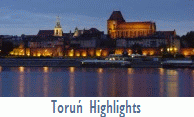
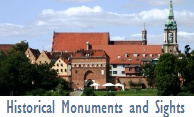




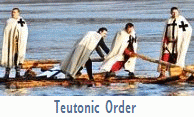














b.bmp)





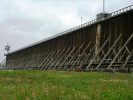







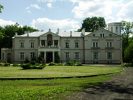
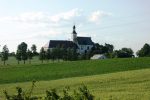


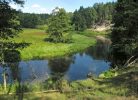

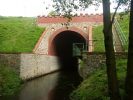






b.bmp) Radzyń Chełmiński *
Radzyń Chełmiński *





